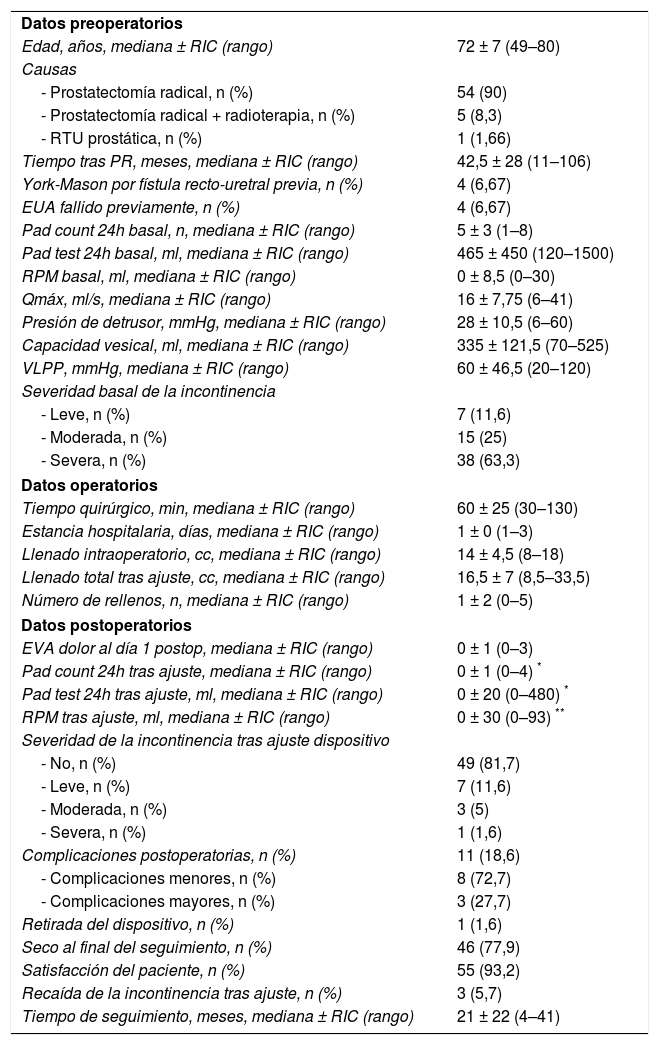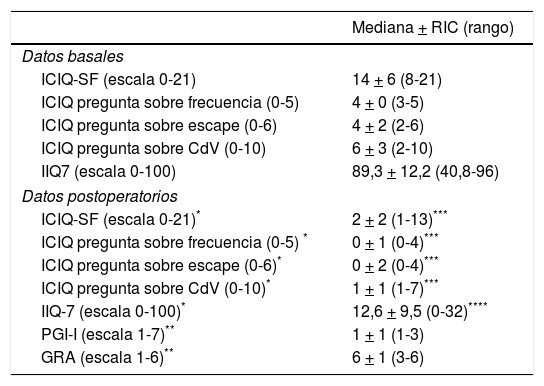La incontinencia urinaria de esfuerzo (IUE) es una secuela importante del tratamiento quirúrgico del cáncer de próstata. Se presenta la técnica quirúrgica y se evalúa efectividad y seguridad del sistema masculino transobturador ajustable (ATOMS®) con puerto escrotal premontado.
Material y métodoEstudio abierto prospectivo realizado en un hospital universitario. El objetivo principal fue cambio de situación basal tras ajuste en el recuento diario de compresas (pad-count) y su peso húmedo (pad-test). Los objetivos secundarios fueron evaluación de calidad de vida (ICIQ-SF e IIQ-7 basal y al ajuste), resultados percibidos por el paciente (PGI y GRA al año) y evaluación de complicaciones según Clavien-Dindo. Los valores numéricos se expresan en mediana + RIC.
ResultadosSe analizan 60 pacientes consecutivos con seguimiento de 21+22meses. El pad-test basal fue 465+450ml y pad-count 5+3 compresas/día. La IUE basal fue leve (11,6%), moderada (25%) y severa (63,3%). El tiempo operatorio fue 60+25min, la estancia hospitalaria 1+0 días y la EVA de dolor en día-1 postoperatorio 0+1. El llenado total fue 16,5+7ml y el número de rellenos 1+2. Pad-test y pad-count tras ajuste fueron 0+20ml y 0+1, respectivamente (ambos p<0,0001 respecto a basal). La IUE desapareció (81,7%) o se mantuvo leve (11,7%), moderada (5%) y severa (1,6%). Se objetivó reducción en ICIQ-SF (p<0,0001) e IIQ-7 (p=0,0003). Tanto la continencia (p=0,002) como la satisfacción (p=0,03) resultaron peores en pacientes irradiados. Sucedieron complicaciones en 11 casos (18,6%), siendo 8(13,5%) grado I y 3(5,1%) grado III. La tasa de satisfacción con el tratamiento fue 91,7% y la percepción de mejoría global percibida por el paciente al año fue muy marcada (score PGI-I 1+1 y GRA 6+1).
ConclusionesEl tratamiento de la IUE masculina con ATOMS® tercera generación es seguro y eficaz a corto plazo, incluso en pacientes con IUE severa. La tasa de pacientes secos tras el ajuste supera el 80% y la tasa de satisfacción el 90%. Los pacientes valoran muy positivamente este tratamiento.
Stress urinary incontinence (SUI) is a significant sequela of prostate cancer surgery. In this article, we present the surgical technique and safety and efficacy of the adjustable transobturator male system (ATOMS®) with preattached scrotal port.
Material and methodAn open prospective study was conducted at a university hospital with the main objective of changing the baseline condition after adjustment in the daily pad count and their wet weight (pad test). The secondary objectives were the quality-of-life assessment (International Consultation on Incontinence Questionnaire-Short Form [ICIQ-SF] and Incontinence Impact Questionnaire-7 [IIQ-7], baseline and after the adjustment), patient-perceived results (Patient Global Index [PGI] and Global Response Assessment [GRA] at 1 year) and assessment of complications according to Clavien-Dindo. The numerical values are expressed in median ± IQR.
ResultsWe analysed 60 consecutive patients with a follow-up of 21±22 months. The baseline pad-test was 465±450mL, and the pad-count was 5+3 pads/day. The baseline SUI was mild (11.6% of patients), moderate (25%) and severe (63.3%). The operative time was 60±25min, the hospital stay was 1±0 days, and the visual analogue scale of pain on day 1 after surgery was 0±1. The total filling was 16.5±7mL, and the number of refillings was 1±2. The pad-test and pad-count after the adjustment were 0±20mL and 0±1, respectively (both p<.0001 compared with baseline). SUI disappeared (81.7%) or remained mild (11.7%), moderate (5%) or severe (1.6%). We observed a reduction in the ICIQ-SF (p<.0001) and IIQ-7 scores (p=.0003). Both continence (p=.002) and satisfaction (p=.03) were lower in the irradiated patients. Complications occurred in 11 cases (18.6%), 8 (13.5%) of which were grade I and 3 (5.1%) of which were grade 3. The treatment satisfaction rate was 91.7%, and the patient-perceived overall improvement at 1 year was highly pronounced (PGI-I score, 1±1; GRA, 6±1).
ConclusionsSUI treatment of men using third-generation ATOMS® is safe and effective in the short-term, even in patients with severe SUI. The rate of dry patients after the adjustment exceeded 80%, and the satisfaction rates exceeded 90%. The patients assessed this treatment highly positively.
Artículo
Comprando el artículo el PDF del mismo podrá ser descargado
Precio 19,34 €
Comprar ahora
















